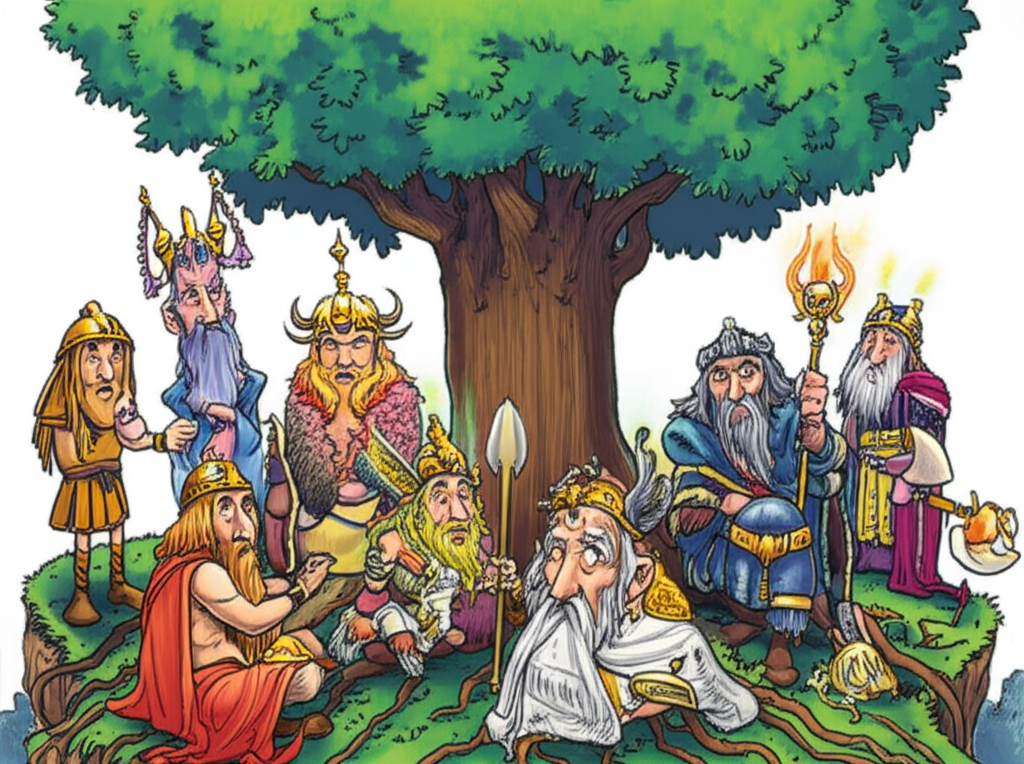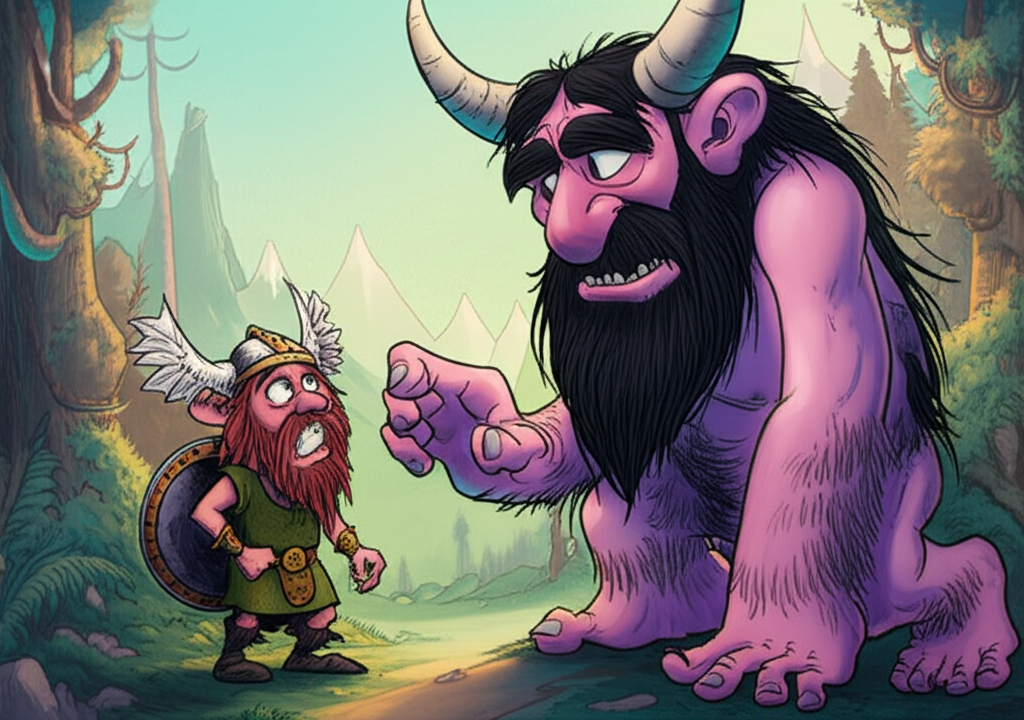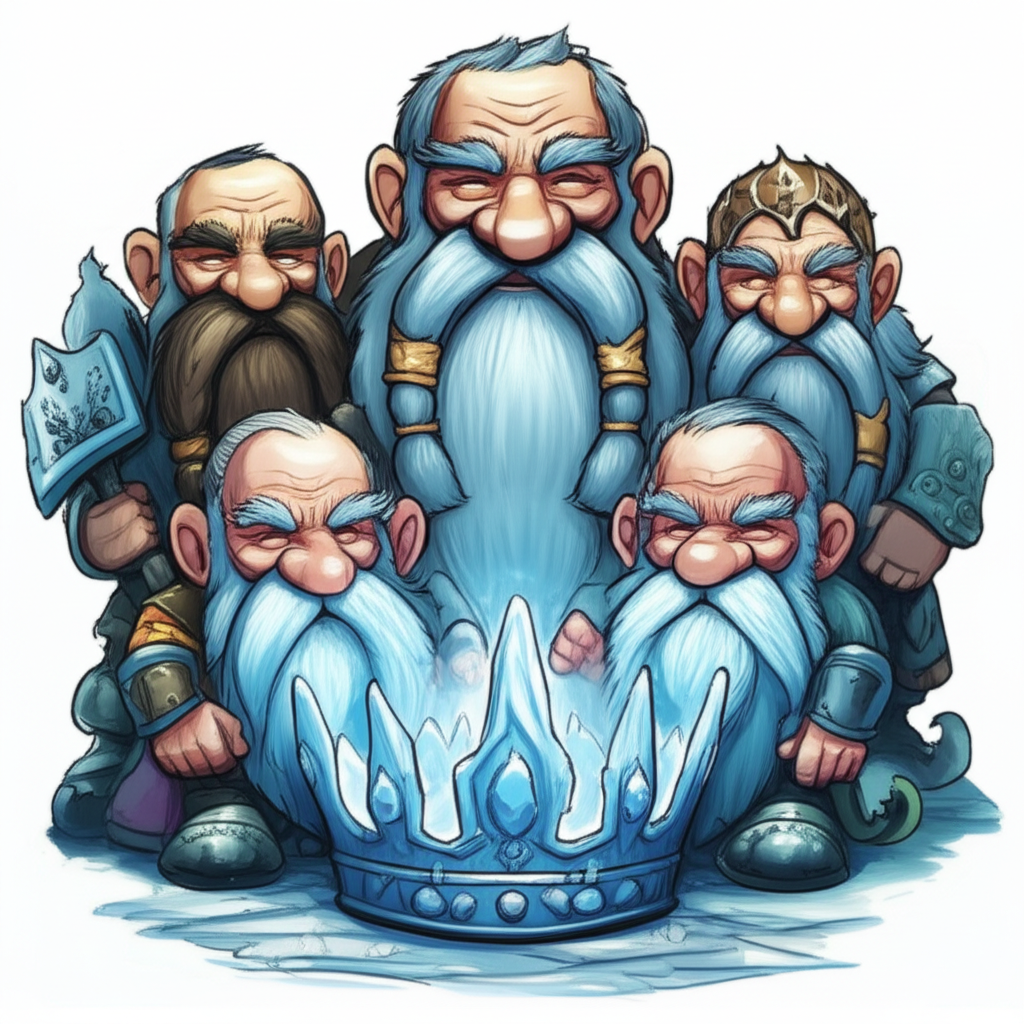
In the frosty expanses of ancient Scandinavia, where longships cut through icy fjords and sagas were carved into the very landscape, a rich tapestry of myth and legend flourished. Among these tales, passed down through generations of oral tradition and later recorded in texts like the Poetic and Prose Eddas, stands the profound narrative of the Aesir–Vanir War. This is a traditional story told by ancient peoples, a foundational myth that sought to explain the origins of divine power, the nature of wisdom, and the delicate balance of the cosmos. It is not presented as historical fact or religious doctrine, but rather as a testament to the imaginative capacity of our ancestors to craft meaning from the world around them.
Echoes of a Northern World: Cultural Roots of the Myth
To understand the Aesir–Vanir War is to glimpse the worldview of the ancient Germanic peoples, particularly those who inhabited the Nordic lands during the Viking Age and the centuries preceding it. Theirs was a society deeply intertwined with the natural world, where the harsh realities of agriculture, seafaring, and warfare shaped their perception of existence. They believed in a cosmos ordered by the colossal World Tree, Yggdrasil, whose branches stretched into nine distinct realms, binding all life together. This was a polytheistic culture, where a pantheon of gods and goddesses embodied forces of nature, human endeavors, and fundamental concepts.
For these people, the world was alive with unseen powers. Fate, often referred to as wyrd, was a powerful, immutable force that even the gods could not fully escape. Honor, courage in battle, and wisdom were highly prized virtues. Their myths were not merely stories; they were explanations for the inexplicable, moral compasses, and reflections of their societal structures and values. The gods were not distant, ethereal beings but powerful entities with human-like flaws and virtues, whose actions directly influenced the mortal realm. The Aesir–Vanir War, therefore, was more than just a divine conflict; it was a cosmic event that redefined the very fabric of their mythological universe.
The Divine Players: Aesir and Vanir
The primary figures in this mythological drama are two distinct groups of deities: the Aesir and the Vanir. These are not real beings but symbolic representations within the ancient Norse narrative tradition.
The Aesir were often associated with kingship, war, justice, and magic. Their stronghold was Asgard, a realm of towering halls and mighty warriors, presided over by Odin, the Allfather – a figure embodying wisdom, war, and poetry. Other prominent Aesir included Thor, the thunder god; Tyr, the god of law and heroic glory; and Frigg, Odin’s wise wife. Symbolically, the Aesir represented the structured, often martial, and intellectual aspects of society, embodying leadership, sacrifice for knowledge, and the establishment of order.
The Vanir, by contrast, were deities intrinsically linked to fertility, prosperity, seafaring, and prophecy. Their home realm was Vanaheim. Key figures among the Vanir included Njord, god of the sea, wealth, and favorable winds; and his children, Freyr, god of fertility, sunshine, and good harvests, and Freya, goddess of love, beauty, fertility, war, and magic. Symbolically, the Vanir represented the life-giving forces of nature, the abundance of the earth and sea, and a more ancient, perhaps chthonic, form of magic and insight into the future. They were often seen as providers of peace and pleasure, distinct from the more martial Aesir. The conflict between these two groups, therefore, could be seen as a mythological exploration of the tension and eventual synthesis between different aspects of life and governance.
The Spark and the Aftermath: A Narrative of Divine Conflict and Reconciliation
The story of the Aesir–Vanir War begins not with a declaration of hostilities, but with a mysterious figure named Gullveig (sometimes identified with Heidr), whose name means "Gold-might" or "Gold-greed." She was a Vanir sorceress, a practitioner of seidr, a potent form of magic often associated with prophecy and manipulation of fate. Gullveig traveled to Asgard, the realm of the Aesir, and her presence brought a new, unsettling energy. She was enamored with gold, sowing discord and avarice among the Aesir, tempting them with promises of wealth and power.
Alarmed by the corruption she spread, the Aesir, in their attempts to rid themselves of this disruptive influence, tried to destroy her. Thrice they seized Gullveig, thrice they pierced her with spears, and thrice they burned her in Odin’s hall. Yet, each time, she was reborn from the ashes, vibrant and whole, mocking their powerlessness to truly end her. This inexplicable resilience, combined with her continued influence, enraged the Aesir.
The Vanir, learning of the brutal treatment of one of their own, saw it as an unforgivable act of aggression and a grave insult. They demanded reparations, a price for the suffering inflicted upon Gullveig. When the Aesir refused to pay, seeing themselves as the offended party by her disruptive magic, the fragile peace between the two divine families shattered. War, swift and terrible, erupted across the realms connected by Yggdrasil.
The Aesir, with Odin leading their charge, hurled their spears into the Vanir host, initiating the conflict. Battles raged, shaking the very foundations of the Nine Worlds. Asgard’s mighty walls, built by a giant craftsman, were breached and crumbled under the Vanir’s sorcery and strength. Both sides suffered immensely, their halls scarred, their warriors fallen. It was a prolonged, brutal conflict where neither side could gain a decisive victory. The gods, immortal as they were, experienced weariness, despair, and the immense cost of endless strife. The cosmic balance was disrupted; the peace that allowed the worlds to flourish was shattered.
Eventually, the wise gods on both sides recognized the futility of continued warfare. The mutual destruction threatened to unravel the stability of all creation. It became clear that the Aesir, with their strength and martial prowess, could not definitively conquer the Vanir, who commanded the subtle, life-giving forces of nature and potent magic. And the Vanir, for all their wisdom and magical might, could not overcome the Aesir’s strategic genius and warlike might. A stalemate, born of exhaustion and a grim understanding of shared vulnerability, led to a truce.
Negotiations began, culminating in a momentous peace treaty. To seal this pact, both the Aesir and the Vanir gathered, and in a symbolic gesture of unity, each god spat into a large vat. From this communal spittle, a being of profound wisdom was created: Kvasir, whose blood was said to be the source of the mead of poetry. This act symbolized the shared sacrifice and wisdom required to forge lasting peace.
The treaty also stipulated a crucial exchange of hostages, a practice common in ancient human societies to ensure compliance and cement alliances. The Vanir sent their most esteemed members to live among the Aesir: Njord, the benevolent god of the sea, and his beautiful and powerful children, Freyr and Freya. In return, the Aesir sent Hoenir, a tall and handsome but somewhat indecisive god, and Mimir, a being renowned for his unparalleled wisdom and counsel.
However, the exchange was not without its complications. The Vanir, finding Hoenir to be less impressive than they had hoped, and perhaps suspecting the Aesir had short-changed them, grew suspicious. They believed they had received a less valuable hostage than they had given. In a moment of anger and perceived betrayal, they decapitated Mimir, the wise counsel, and sent his head back to Odin.
Odin, heartbroken but undeterred by the loss of his wise advisor, refused to let Mimir’s wisdom perish. He preserved Mimir’s head with herbs and incantations, consulting it frequently for guidance. This act ensured that even in death, wisdom could continue to serve the divine and, by extension, the cosmos.
With the exchange completed and the initial tensions quelled, the Aesir and Vanir began the long process of integration. Njord, Freyr, and Freya were welcomed into Asgard, eventually becoming revered members of the Aesir pantheon. Freya, in particular, became an important goddess, teaching the Aesir the powerful magic of seidr, which had been a Vanir specialty. This integration was the true aftermath of the war, a re-forging of the divine order under the great tree Yggdrasil. The two distinct families of gods, once warring, now lived in a fragile but functional peace, their unique strengths and wisdom intertwined, setting the stage for the future of the Nine Realms. The cosmic balance was restored, though forever altered, until the prophesied twilight of the gods, Ragnarok.
Symbolism and Enduring Meaning
For the ancient Norse people, the Aesir–Vanir War and its aftermath held profound symbolic meaning. It represented the essential need for reconciliation and alliance between different societal elements or even different tribes. The Aesir, embodying martial power and structured order, learned that they could not thrive without the fertility, prosperity, and deeper magical insights of the Vanir. Conversely, the Vanir recognized the necessity of the Aesir’s strength for defense and governance. The story suggests that true power lies not in dominance, but in the harmonious integration of diverse strengths.
The creation of Kvasir from communal spittle symbolizes the birth of wisdom and poetry from shared experience and sacrifice. Mimir’s preserved head underscores the eternal value of wisdom and the lengths one must go to retain and honor it. Odin’s act demonstrates a profound respect for counsel and knowledge, a virtue highly esteemed in their society.
Furthermore, the war might have been an etiological myth, explaining the origins of certain societal practices or the co-existence of different religious cults. It could reflect the historical merging of different cultures or the absorption of an older, fertility-focused religion by a newer, more warlike one. It also speaks to the cyclical nature of conflict and resolution, a constant ebb and flow that ultimately leads to a new, albeit sometimes uneasy, equilibrium. The war and its peace solidified the divine structure, laying the groundwork for the interactions between gods and mortals that would define their world.
Modern Interpretations and Cultural Resonance
Today, the Aesir–Vanir War continues to captivate and inspire, finding new life in various forms of modern media. In literature, especially fantasy novels, the theme of warring pantheons or tribes eventually finding common ground is a recurring motif, often drawing directly from Norse mythology. Authors and storytellers find rich inspiration in the distinct characteristics of the Aesir and Vanir, their complex motivations, and the high stakes of their conflict.
Movies and television series have brought these myths to a global audience, most notably through the Marvel Cinematic Universe, which reimagines figures like Thor and Odin. While these adaptations often take liberties with the source material, they introduce the core concepts of Asgard, the gods, and their conflicts to new generations. Similarly, in video games, titles like "God of War" and "Assassin’s Creed Valhalla" immerse players in the Norse mythological landscape, allowing them to interact with the gods and experience narratives inspired by these ancient tales.
Academically, the Aesir–Vanir War remains a fascinating subject for cultural studies and comparative mythology. Scholars analyze its structure, symbolism, and parallels with other mythologies, seeking deeper insights into the human condition, ancient societal structures, and the universal patterns of storytelling. It serves as a reminder of the enduring power of narrative to shape cultural identity and transmit values across millennia.
A Legacy of Imagination
The Aesir–Vanir War, like all myths, is a profound cultural story, not a belief system to be adopted or practiced. It is a testament to the vivid imagination and deep philosophical insights of ancient peoples, who sought to understand the complexities of their world through grand narratives of divine conflict and reconciliation.
As Muslims, we recognize that only Allah is the true Creator and Sustainer of the universe, and that He is utterly unique, without peer or partner. Our faith teaches us to understand the world through His revealed truth. However, acknowledging the cultural and historical significance of stories like the Aesir–Vanir War allows us to appreciate the diverse tapestry of human thought and creativity. These ancient myths, born from a different time and worldview, offer valuable windows into the human experience, reminding us of our shared heritage of imagination, storytelling, and the timeless quest for meaning. They are echoes of humanity’s past, resonating still in our modern world as powerful, educational narratives.





